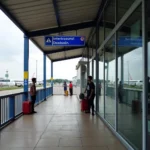Creating a realistic virtual airport environment in 3ds Max is a challenging yet rewarding undertaking. Whether you’re a game developer, an architect, or a visual artist, understanding the intricacies of modeling underconstruction airports can elevate your 3D projects to a new level of realism and detail. This guide will walk you through the process, equipping you with the knowledge and techniques to construct immersive airport scenes.
Why Model Underconstruction Airports in 3ds Max?
Modeling underconstruction airports in 3ds Max offers a unique set of challenges and opportunities. This process allows you to:
- Capture the dynamic nature of construction: Underconstruction sites are constantly evolving, presenting a dynamic environment that can be replicated with 3ds Max tools.
- Showcase architectural design: Model the intricate details of airport structures, from the complex structural elements to the intricate interior designs.
- Create realistic simulations: Simulate construction equipment, workers, and the overall hustle and bustle of a building site.
- Visualize future scenarios: Imagine and visualize the completed airport, providing a valuable tool for developers and architects.
Building a Realistic Airport Model: A Step-by-Step Guide
1. Planning and Conceptualization:
- Gather References: Research real-world underconstruction airports through photographs, videos, blueprints, and architectural drawings.
- Define the Scope: Determine the size and complexity of your model, focusing on specific areas or the entire airport complex.
- Design Concept: Create a clear concept for your airport, considering architectural style, design elements, and the overall aesthetic.
2. Modeling the Airport Structure:
- Begin with the Foundation: Model the airport foundation using basic shapes and modifiers, ensuring accurate dimensions and details.
- Construct the Framework: Create the structural framework, including beams, columns, and supporting structures, using tools like Extrude and Bevel.
- Add Architectural Elements: Incorporate specific design features like windows, doors, roofs, and cladding materials using materials and textures.
3. Creating Construction Details:
- Model Construction Equipment: Utilize 3ds Max’s modeling tools to create cranes, excavators, bulldozers, and other equipment common to construction sites.
- Add Scaffolding and Fencing: Model scaffolding, barriers, and fences to create a realistic construction environment.
- Include Construction Materials: Create 3D models of concrete blocks, steel beams, brick, and other materials used in the construction process.
4. Incorporating Environmental Elements:
- Add Terrain: Model the surrounding terrain, including hills, valleys, and vegetation to create a realistic landscape.
- Create Lighting: Utilize 3ds Max’s lighting tools to simulate natural sunlight, artificial lighting, and the effect of shadow and contrast.
- Include Vehicles and People: Model cars, trucks, and pedestrian figures to enhance the realism of the scene.
5. Texturing and Materials:
- Apply Realistic Textures: Utilize high-resolution textures to capture the nuances of concrete, metal, wood, and other materials.
- Create Variation: Use different textures and materials for the airport structure, construction equipment, and surrounding environment.
- Add Details: Incorporate wear and tear, imperfections, and subtle details to make your model more realistic.
6. Animation and Rendering:
- Animate Construction Equipment: Utilize 3ds Max’s animation tools to create realistic movements for cranes, excavators, and other equipment.
- Add Dynamic Elements: Animate construction workers, vehicles, and other elements to bring your scene to life.
- Choose the Right Render Engine: Select a suitable render engine based on your project’s requirements for speed, quality, and features.
Expert Insights:
“Modeling underconstruction airports in 3ds Max is like capturing a moment in time,” shares Johnathan Davis, a renowned 3D artist specializing in architectural visualization. “It’s about showcasing the dynamic energy of a construction site, the intricate details of the structures, and the gradual transformation of an unfinished project into a functional airport.”
Frequently Asked Questions:
-
Q: What are the best tools in 3ds Max for modeling underconstruction airports?
A: 3ds Max offers a range of tools, including Extrude, Bevel, and Boolean operations, for modeling the airport structure. For construction details, use tools like the Editable Poly, Editable Mesh, and the Create Panel for custom modeling.
-
Q: What are the essential aspects of creating realistic textures?
A: Focus on using high-resolution textures, incorporating wear and tear, and ensuring accurate color and material representation.
-
Q: How can I achieve realistic lighting and shadows in 3ds Max?
A: Experiment with different lighting setups, using spotlights, area lights, and HDRI images to achieve accurate lighting and shadows.
Conclusion:
Modeling underconstruction airports in 3ds Max is a complex yet rewarding experience that allows you to showcase your 3D modeling skills and create stunning visuals. By following these steps and incorporating expert insights, you can transform your 3D model from a simple concept into a realistic and immersive airport scene.
